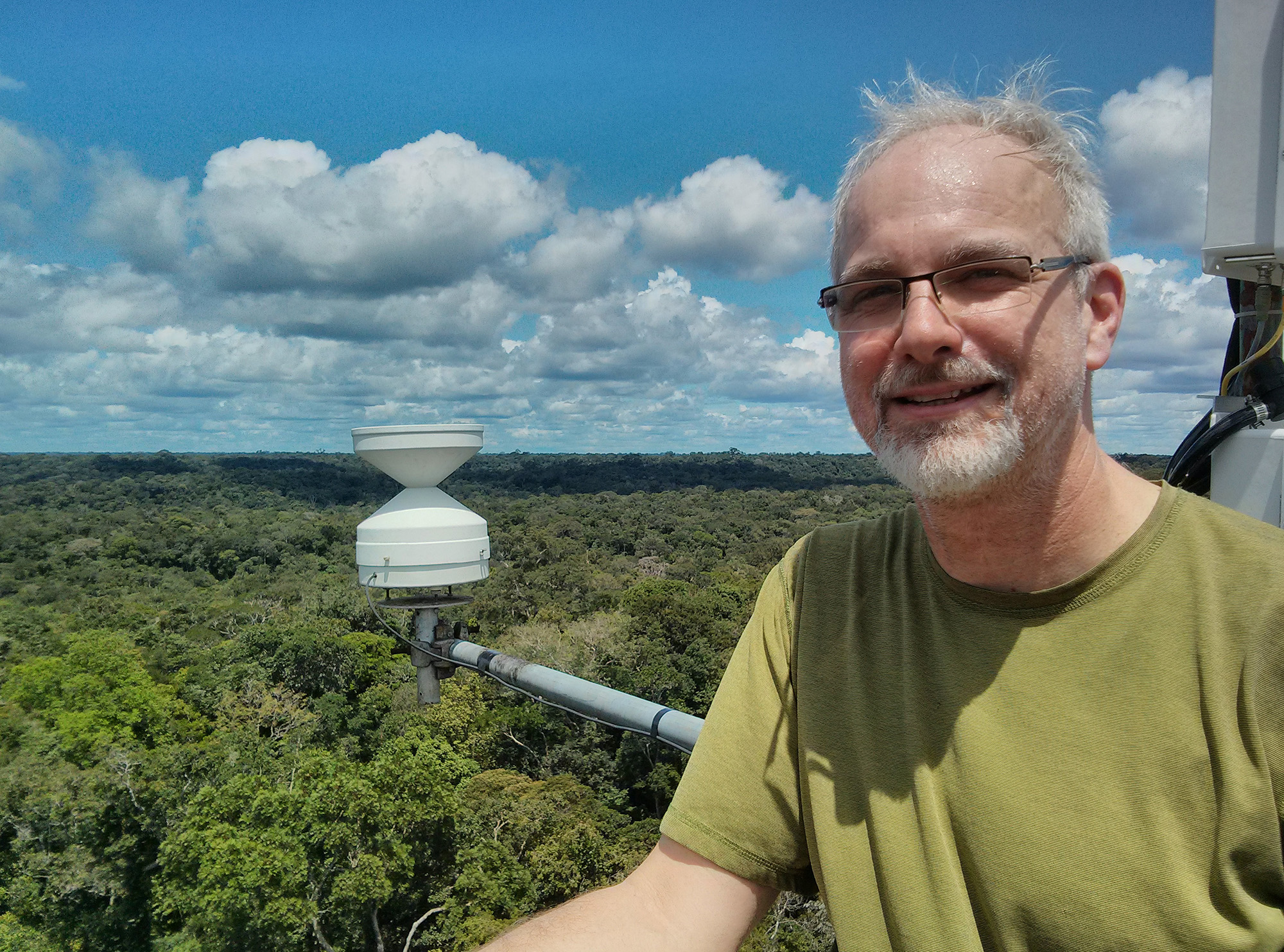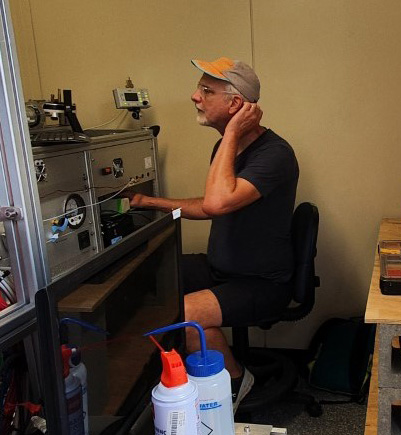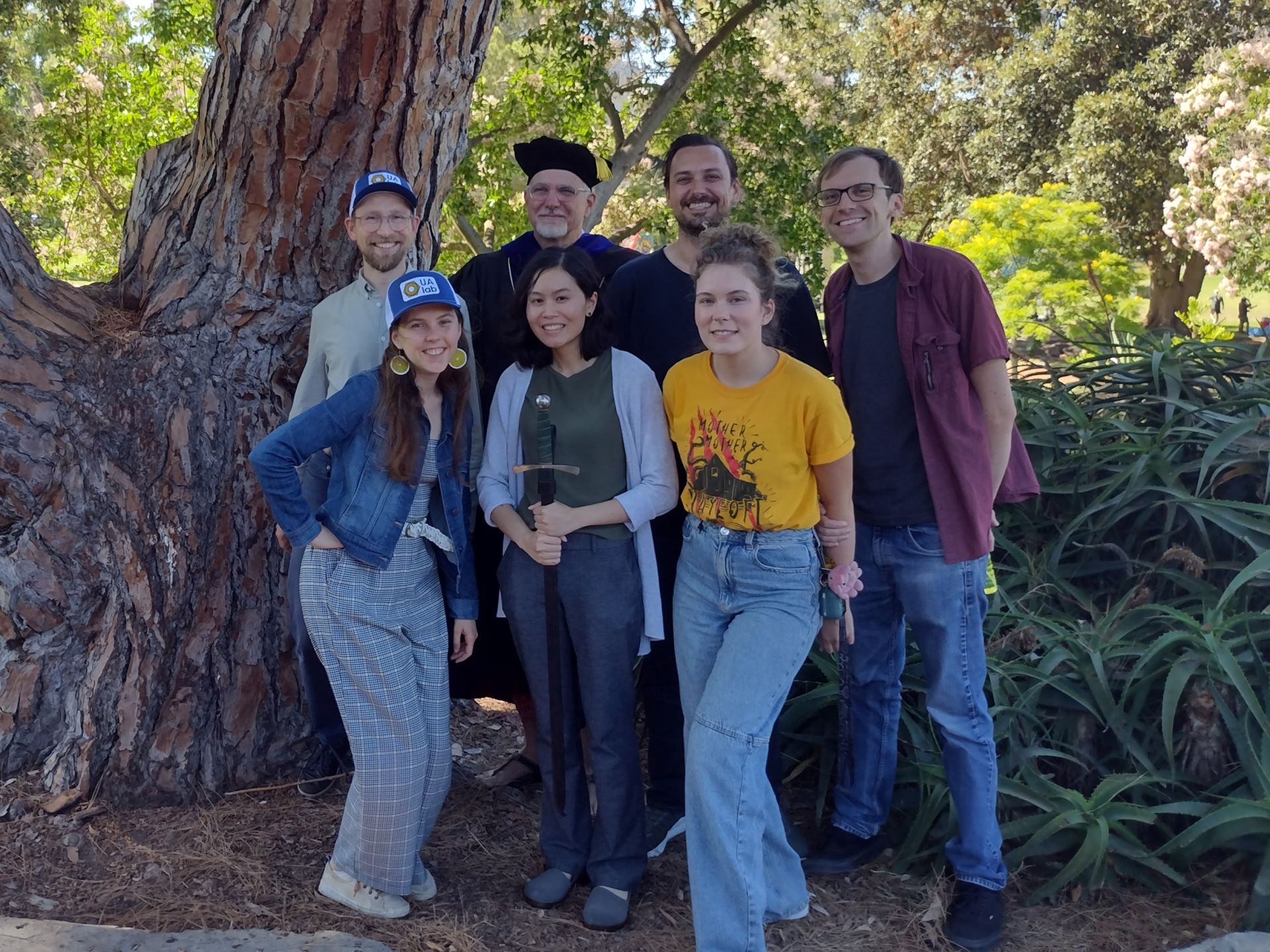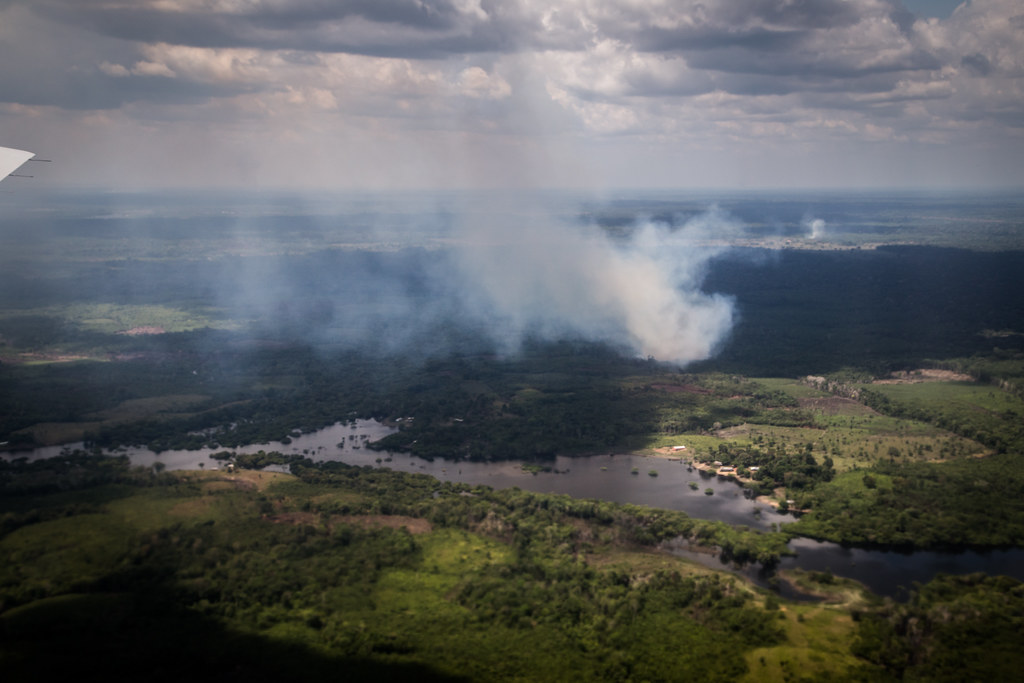
A veteran California researcher digs into the origins and makeup of the atmosphere’s tiniest particles
James “Jim” Smith, a professor of chemistry at the University of California, Irvine, was just a boy when his father, a summertime park ranger, brought him into the wilderness for weeks at a time. He and his brothers jumped into creeks, got scuffed up, and watched clouds scud overhead.
From those moments on, “I realized how much I loved science,” says Smith. “I always knew, wherever I ended up, it would have to do with being out in the natural world.”
In time, he entered a science career that brought him back to clouds and how they are made. Smith studies ultrafine atmospheric particles so tiny (100 nanometers wide) you could fit a thousand of them across the width of a human hair.
Some of the particles Smith can measure and study are just 4 nanometers across―less than twice the diameter of a strand of DNA.
Particles heavy enough to fall out of the atmosphere are more commonly a hundred times bigger, up to 10 microns across. That’s about the size of a droplet that results from coughing.
As ultrafine particles grow to 100 nanometers, they can make clouds and precipitation possible. At this size, particles are thought to have an especially critical role in marine cloud formation.
A second boyhood interest contributed to Smith’s path into science. He was younger than 10 when he started rebuilding and repainting “old junky bikes” for neighbors in his backyard, Smith says. “That was my earliest memory of tinkering with stuff―and maybe getting a little over my head on some things.”
A fascination with how machines work endured through graduate school at the California Institute of Technology (PhD, 2000). There, he not only studied nanometer-size atmospheric particles but how he could peer into them with devices that unmask their molecular composition.
Two ASR Projects

Smith and his ultrafine aerosol group at UC Irvine have studied such particles in the last few years, in part because of grants from the Atmospheric System Research (ASR) program at the U.S. Department of Energy (DOE).
The 2020―2023 project is just wrapping up. Smith led a team looking at the formation of nanometer-size particles and their impacts in the stormy coastal region around Houston, Texas. The venue was the TRacking Aerosol Convection interactions ExpeRiment (TRACER) field campaign, a multi-institution investigation of atmospheric, land, and sea factors that contribute to convective storm activity.
The more recent ASR project, slated for 2022 and 2025, investigates how ultrafine particles couple with marine environments. The core of Smith’s field work took place in the spring of 2023 in coastal La Jolla, California as part of the still-ongoing Eastern Pacific Cloud Aerosol and Precipitation Experiment (EPCAPE).
Both campaigns were sponsored by the DOE’s Atmospheric Radiation Measurement (ARM) user facility, which maintains fixed and mobile observatories in climate-critical regions of the world.
‘A Difficult Life’
The science missions and the instrumentation for TRACER and EPCAPE were different. But the focus of each study was the same: ultrafine aerosols, which scientists don’t know much about. For one, they are so tiny and difficult to measure. For another, they don’t live long―sometimes less than a few minutes.
Smith is intrigued by what he calls the “difficult life” of ultrafine particles. They get batted around by gas molecules. They get lost when clinging to surfaces. And they get “swallowed up, if you will, by larger particles,” he says.
But nanometer-size aerosol particles―nanoparticles―are critically important to the processes that make larger particles.
Nanoparticles form in huge swarms―tens of thousands within a cubic centimeter of air. (One centimeter is about the width of a pencil.) If even a millionth of them survive, says Smith, they “can grow to make a real difference in cloud formation and precipitation.”
Studying them is “a frontier,” he says, an investigation of a “dynamic relationship between particles and gases that is constantly evolving and changing: an interesting gradient, a quasi-gas, quasi-particle regime very different than would exist for much larger particles.”
TRACER and the CAGE

The Smith team employed traditional measurement strategies during EPCAPE to identify the chemical composition of sampled ultrafine particles, as well as their hygroscopicity―that is, how much water they absorb.
But during TRACER, “we took a completely different and really interesting approach,” said Smith, who led a subsidiary field campaign in July and August 2022 called TRACER Ultrafine Aerosol Formation and Impacts (UFI).
With co-investigators Don Collins (University of California, Riverside) and Jeffrey Pierce (Colorado State University), he took on the complicated oceanside, industrialized atmosphere around Houston by creating a hybrid laboratory-field experiment.
The aim was to uncover the processes behind ultrafine particle formation in the atmosphere, in part by identifying the gases that are responsible for their growth. To accomplish this, they took samples of Houston air into a Collins invention called the Captive Aerosol Growth and Evolution (CAGE) chamber.
About the size of two refrigerators side by side, CAGE allows researchers to put filtered, ambient air into a chamber, then watch the process as the gases transform and cause particles to form and grow.
With CAGE, “we could say with 100% certainty that those particles came from the gases we put in,” says Smith. “When we make measurements in the atmosphere, we often make the false assumption that the particles we are studying have something to do with the gases passing by.”
The atmosphere is not a smooth, linear conveyor belt of gases, but more like a neighborhood with city-like corners and complexities.
“You can measure particles in one spot and assume that spot represents conditions throughout the atmosphere,” he says, “but just around the corner there may be a semi-truck idling.”
With the CAGE strategy, says Smith, “we step back and mimic well-controlled laboratory experiments, but do so with real urban air.”
EPCAPE and Aerosol Chemistry

Marine clouds are sensitive to the presence of aerosols. If you look at a satellite image of an ocean surface, you see streaks of “clouds” created by passing ships as their smoke trails seed clean ocean air.
In a similar way, the marine clouds studied along the coastline during EPCAPE “are critically dependent” on the population of particles that exists there, says Smith, whose team spent two months on site in May and June 2023.
Some particles flow in from the relatively clean ocean air. Others are affected by human-made emissions along a partly industrialized coastline.
“EPCAPE is primarily a cloud study,” says Smith. “We’re jumping in from an aerosol-science perspective. We hope to provide insights into how this population of particles play a role in the cloud properties they are studying.”
The La Jolla marine coastline was an interesting setting, he says, “with this beautiful particle-generating system operating 24/7.”
That system of constant wave action creates bubbles that burst, sending particles into the air―a medley of salts, gases, and even microorganisms.
For scientists, the EPCAPE site was also interesting because instruments at a seaside pier can be compared to those less than a mile away on Mt. Soledad, which sometimes sits directly within coastal clouds.
So far, says Smith, his role in EPCAPE has yielded some intriguing hints.
For example, the ultrafine particles they sampled seem more volatile, chemically, than ordinary salts would be. Also, sulfur seems to have a huge role in the formation of these particles. And instruments have picked up evidence of fatty acids and polysaccharides, which originate in what is a biologically active sector of the Pacific Ocean.
‘Traditional Measures’ of Aerosol Particles

Unlike Smith’s non-traditional science mission during TRACER, EPCAPE witnessed what he calls “traditional measures” of nanoparticles and their chemical composition.
One way is to heat captured particles until they become a gas, which is easier to measure than the particles themselves. For that, the Irvine team used a thermal desorption chemical ionization mass spectrometer (TDCIMS), “our bread-and-butter instrument,” says Smith, who has used it widely, including in Switzerland, Finland, Amazonia Brazil, and Colorado.
At EPCAPE, the Smith team also deployed ways to determine particle composition indirectly: by measuring particle volatility and hygroscopicity―that is, how easily particles evaporate when heated and how much water they tend to absorb.
For instance, a particle made from sea salt is non-volatile (does not evaporate readily) and hydrophilic (water-loving).
Smith and his team also used a proton transfer reaction-mass spectrometer (PTR-MS) to measure organic gases in the air. It ran for about a month after being trucked up from the Irvine campus, which is about an hour from La Jolla.
What gases coexist with the captured nanoparticles? The PTR-MS, despite its brief tenure on site, “will give us some critical information,” says Smith.
‘I Was Always Asking: Why?’
Growing up in San Jose, California, Smith sailed through high school, buoyed by his love of science, the outdoors, and tinkering.
But his years at Harvey Mudd College (B.S. Physics, Philosophy minor) did not lead directly to studying clouds or aerosols.
Smith says, “I navigated a circuitous path of what it was I loved.”
There was physics, for one, as well as “religious philosophy,” he says. “I was always asking: Why?”
“There’s an intellectual growth that comes from teaching. You’ve got to teach yourself something, then explain it to someone else.”
– Jim Smith
For seven years after his bachelor’s degree, Smith worked for a small startup instrumentation company.
“I fell into a role of developing optical instruments for measuring droplet size,” he says. “It was pretty exciting.”
Around 1990, a project to measure super-cooled droplets took him to Mt. Washington in New Hampshire, the highest peak in the Northeast and said to be the windiest place on Earth. During winter, everything at the observatory there is coated with armor-like sheets of ice.
“And I said: You know, this is it,” remembers Smith. “I want to be the person who goes to the top of Mt. Washington and makes measurements of stuff.”
It was time for graduate school.
Those Who Lit the Way
At Caltech, Smith was years older than most PhD students in his class, who had just finished undergraduate degrees.
“Most of them were burnt out,” he says. “I was just the opposite.”
In class, Smith focused like a laser, pent up with the energy to learn. In meetings with advisors, he wrote and printed out agendas.
And what mentors they were, says Smith. Richard C. “Rick” Flagan is a top-rated aerosol scientist. Jesse L. “Jack” Beauchamp is a chemist with a deep interest in mass spectroscopy and other instrumentation that peers into molecules. (Beauchamp pronounces his name “BEECH-um.”)
Between his two mentors, he says, graduate work “provided this great, beautiful connection between aerosols and (what was then) this new area of mass spectrometry.”
It also provided a family. Both his children were born when Smith was in graduate school. His daughter is now in a PhD psychology program, and his son just graduated with a degree in city planning. His wife, now retired, was a teacher.
Smith is “super-grateful to both Flagan and Beauchamp,” who among other things steered him to chemistry and in the last year of his PhD work, “inexplicably” allowed him to spend a research year in southern Sweden. “They allowed me a great amount of flexibility and creativity.”
Over the years, “I could name a half dozen of people who showed me the way, essentially,” says Smith, including high school teachers. “They are the people who light the path for you.”
To the Field, to the Classroom

After earning his PhD, Smith spent 15 years at the National Center for Atmospheric Research (NCAR) in Boulder, Colorado. While there, ever the tinkerer, he led the development of the TDCIMS instrument used during EPCAPE and elsewhere.
His NCAR team also developed a biogenic aerosol chamber to study plant emissions, including secondary organic aerosols created by plant-sunlight interactions.
Smith’s interest in land-atmosphere interactions, including links between carbon and water cycles, informed his design and development of NCAR’s Manitou Experimental Forest Observatory in a ponderosa pine ecosystem in the arid central Rocky Mountains of Colorado.
“You really don’t know anything about what’s going on in the atmosphere,” says Smith, “unless you understand what going on with terrestrial environments.”
He was still at NCAR when he took part in ARM’s GoAmazon 2014/15: Green Ocean Amazon field campaign in Brazil to study the Amazonian hydrological cycle. It’s a rich locale for investigating biogenic influences on the atmosphere, so Smith stayed on for similar work after he joined UC Irvine as a professor.
“There’s an intellectual growth that comes from teaching,” Smith says of his university career. “You’ve got to teach yourself something, then explain it to someone else.”
Fittingly, he taught a new class during the Spring quarter 2023 on advanced instrumental analysis: “Right in my wheelhouse,” says Smith.
Emissions from Tires and Brakes
After work, Smith tools around on his vintage 1990 Trek 520 touring bike and even occasionally joins group tours of 500 miles or so. (One was from Irvine to Phoenix, Arizona.)
Bicycles (which he still repairs for friends) are “a great way to see the landscape efficiently,” he says, though increasingly, he likes to bike-pack on remote dirt trails. It’s safer.
Much wider tires are on Smith’s mind too.
He and his group have expanded their studies of atmospheric ultrafine particles. They are investigating the little-known nanoparticles created by the hot friction of automobile brakes and by the wear on tires that burn and wiggle along countless roadways.
Aside from nanoparticles, “tires and brakes create many gases, most of which air quality regulators are completely unaware of,” says Smith, whose group is busy re-creating such emissions in a controlled, lab-like environment. “Hot brakes can be like a little smoldering wildfire inside your wheel. The little things add up.”
The project depends on a two-year, $2 million grant, which―not so oddly―is from the California Department of Justice. Such roadside emissions, covert and plentiful, often affect poor urban communities the most.
The same project team is also designing a mobile instrument platform to detect marker compounds for brake and tire emissions. Santa Ana, California, will be the test case.
“In addition to EPCAPE,” says Smith, the study of brake-and-tire vehicle emissions “has occupied a lot of our time these days.”
# # #Author: Corydon Ireland, Science Writer, Pacific Northwest National Laboratory
This work was supported by the U.S. Department of Energy’s Office of Science, through the Biological and Environmental Research program as part of the Atmospheric System Research program.

